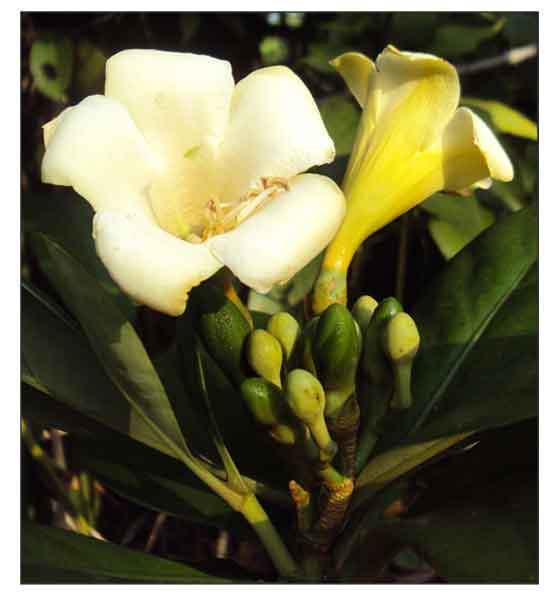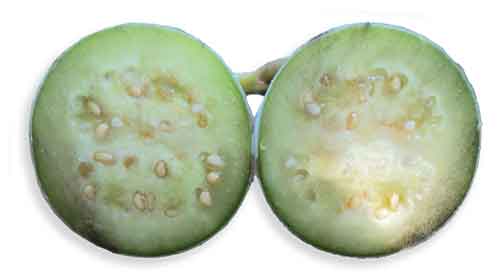
Family • Gentianaceae
Bankalon
Busalsal
Fagraea ceilanica Thunb.
PERFUME FLOWER TREE
Hui li
| Scientific names | Common names |
| Atragene ceilanica (Thunb.) | Bankalon (Tag.) |
| Bertuchia speciosa Dennst. ex Kostel. | Busalsal |
| Fagraea birmanica Gand. | Kotongogan |
| Fagraea ceilanica Thunb. | Malatunog |
| Fagraea chinensis Merr. | Mamagon |
| Fagraea garnderi Thwaites | Panagang |
| Fagraea khasiana Benth. | Pospusug |
| Fagraea malabarica Wight | Pukut |
| Fagraea malabarica Blume | Fragrant fagraea (Engl.) |
| Fagraea ovata Wall. | Fragrant pear (Engl.) |
| Fagraea ovata var. gardneri (Thwaites) C.B.Clarke | Perfume flower tree (Engl.) |
| Fagraea prainii Gand. | |
| Fagraea rostrata Blume | |
| Fagraea sasakii Hayata | |
| Gardenia heteroclyta J.Koenig ex Blume | |
| Hillia prasiantha Lem. | |
| Solandra oppositifolia Loudon ex G.Don | |
| Solandra oppositifolia Moon | |
| Willughbeia ceilanica (Thunb.) Gera | |
| Fagraea ceilanica Thunb. is an accepted species. KEW: Plants of the World Online | |
| Other vernacular names |
| BORNEO: Akar sempirai, Kayu alah, Penungpang, Salang mapit, Seraya. |
| CHINA: Hui li. |
| INDIA: Kompal, Marunthankamaram, Modakakkodi, Modakam, Omal, Vallerei, Vellarimodakam (Malayalam), Hanna challe (Kannada). |
| INDONESIA: Tamosu, Kolaki, Nosu. |
| LESSER SUNDA IS: Kikunteh, Kiterong, Kemrungen, Kepitu, Rauai kajarok. |
| MALAYSIA: Ara burong. |
| MOLUCCAS: Papatjeda bangan, Papatjeda utan, Pasi gunung, Tonki utan, Mengando. |
| NEW GUINEA: Kulaken, Kuleka. |
| SIMALUR: Angilaan bilu, Bani-bani, Luam Olor arelah. |
| SRI LANKA: Etamburu (Sinhala), Ettamura. |
| SUMATRA: Kaju djottik. |
| THAILAND: Fa mue ph i, Phoda, Niu nang sawan, Nang sawan, Thian ruese, Konkang khao. |
| VIETNAM: Trai xoan, Lau binh, Day gia. |
| OTHERS: Pua keni keni, Trai trichlan. |
Botany
• Growth form: Large shrub or small tree usually up to 10 m tall. Foliage: Smooth, glossy leaves are fleshy and thick. Flowers: Large, trumpet-shaped flowers are strongly fragrant. They open white, turn yellow by the next day and quickly fade after that. Fruit: Jade green, glossy fruit is round with a pronounced beak. (5)
Constituents Properties Availability |
September 2024
![]()
 |
| PHOTOS / ILLUSTRATIONS |
| IMAGE SOURCE: Fagraea ceilanica / Vinayaraj / CC BY-SA 3.0 Unported license / Click on image or link to go to source page / Wikipedia |
| OTHER IMAGE SOURCE: Fagraea ceilanica fruit / Vinayaraj / CC BY-SA 3.0 Unported license / Click on image or link to go to source page / Wikimedia Commons |
| OTHER IMAGE SOURCE: Fagraea ceilanica fruit / Vinayaraj / CC BY-SA 3.0 Unported license / Click on image or link to go to source page / Wikimedia Commons |
| OTHER IMAGE SOURCE: Fagraea ceilanica leaf / Vinayaraj / CC BY-SA 3.0 Unported license / Click on image or link to go to source page / India Biodiversity Portal |
Additional
Sources and Suggested Readings |
• |
DOI: It is not uncommon for links on studies/sources to change. Copying and pasting the information on the search window or using the DOI (if available) will often redirect to the new link page. (Citing and Using a (DOI) Digital Object Identifier) |
| List of Understudied Philippine Medicinal Plants |
| New plant names needed The compilation now numbers over 1,500 medicinal plants. While I believe there are hundreds more that can be added to the collection, they are becoming more difficult to find. If you have a plant to suggest for inclusion, native or introduced, please email the info: scientific name (most helpful), local plant name (if known), any known folkloric medicinal use, and, if possible, a photo. Your help will be greatly appreciated. |
• |
 |

 Gen info
Gen info

 Folkloric
Folkloric